
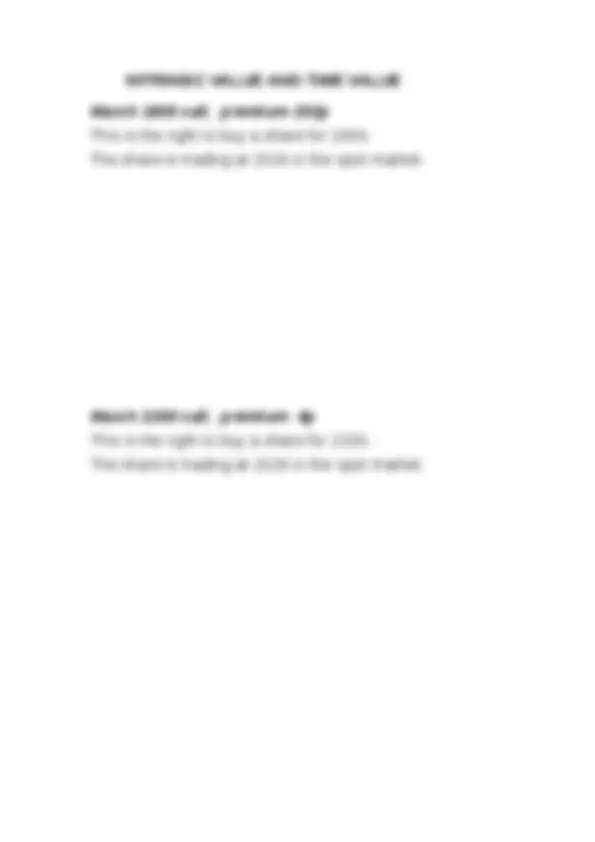
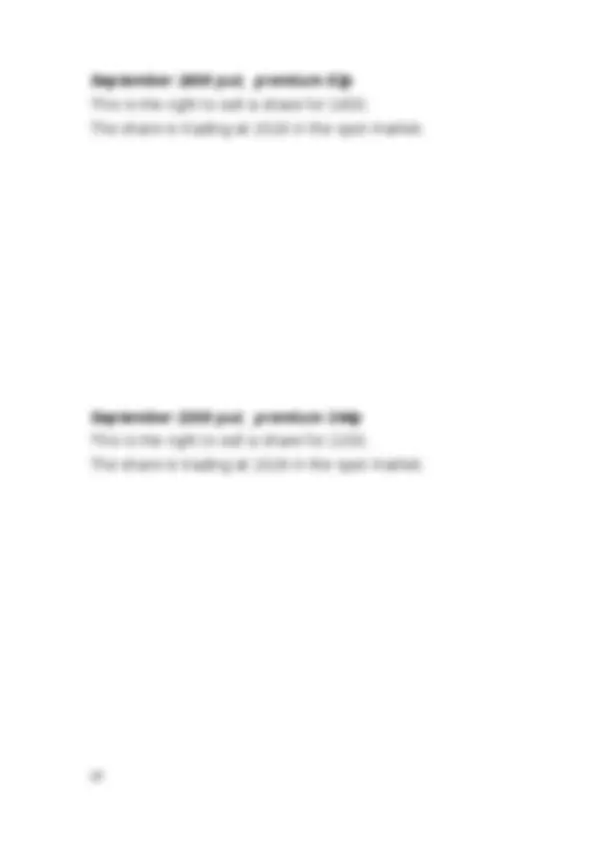
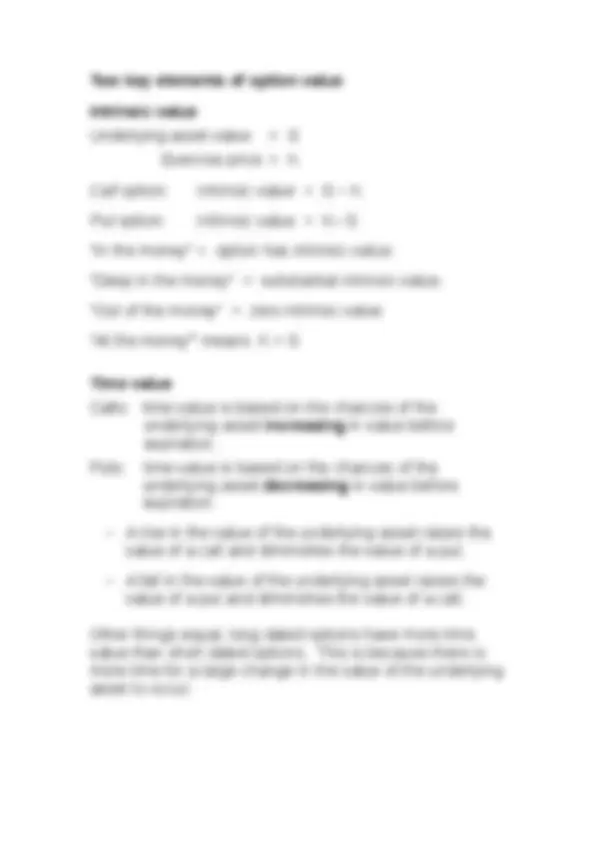
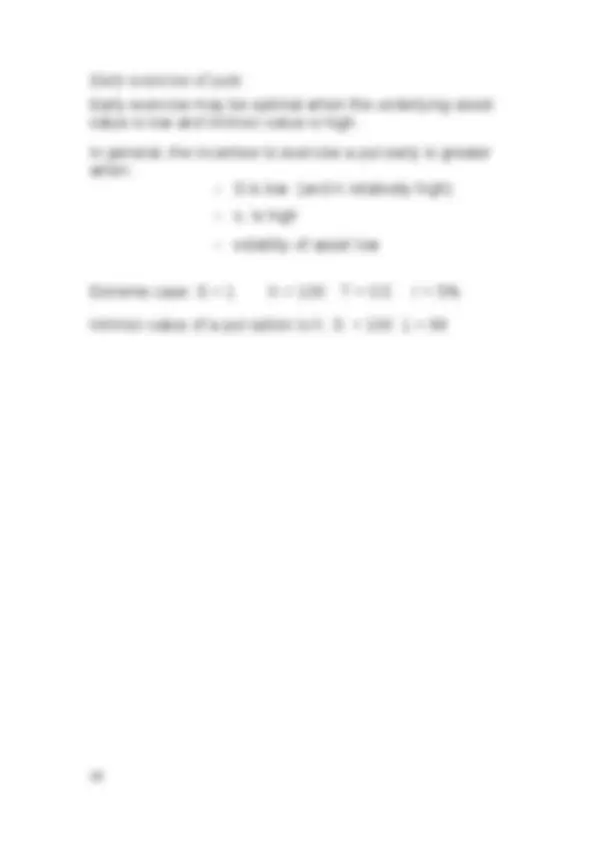

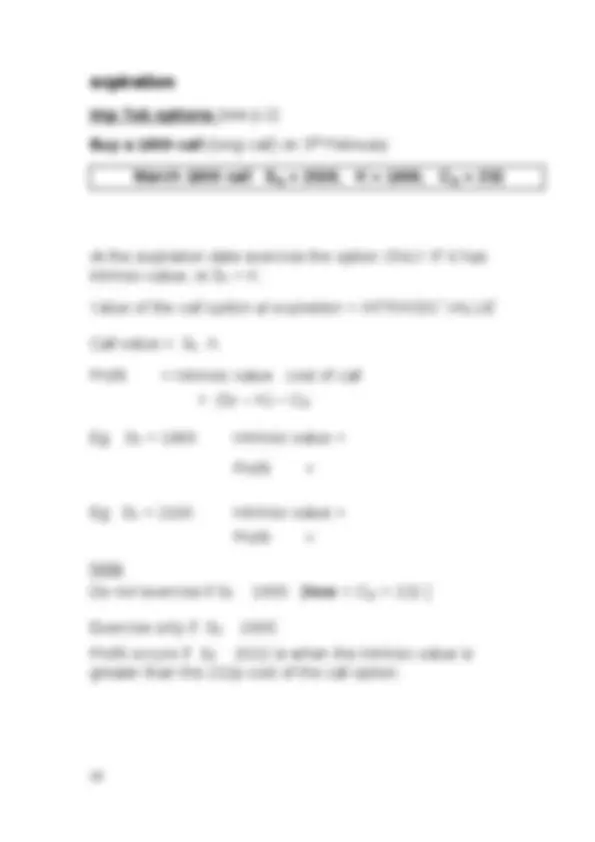
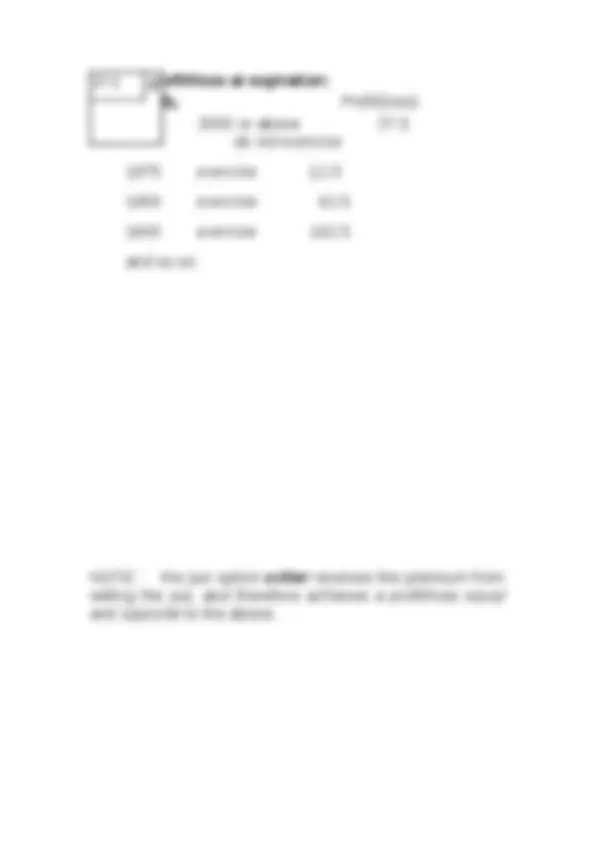
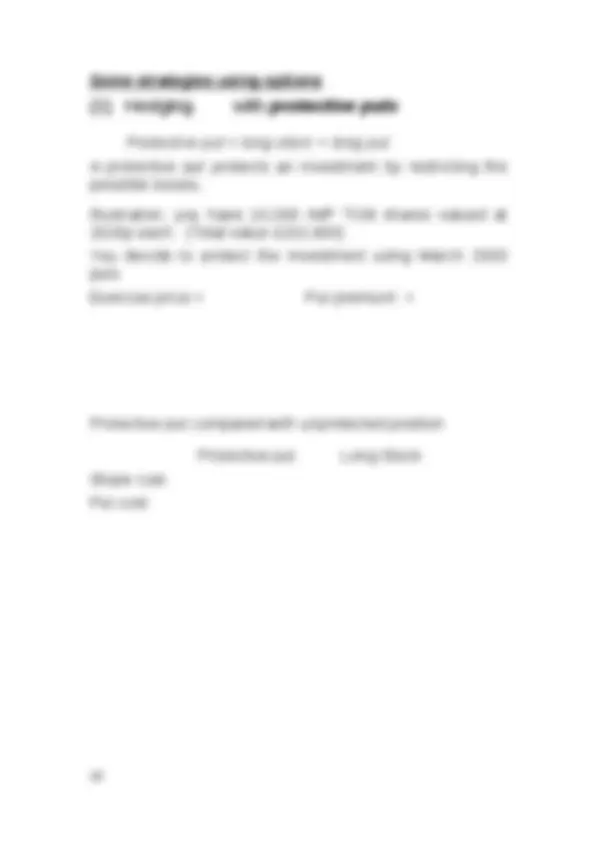
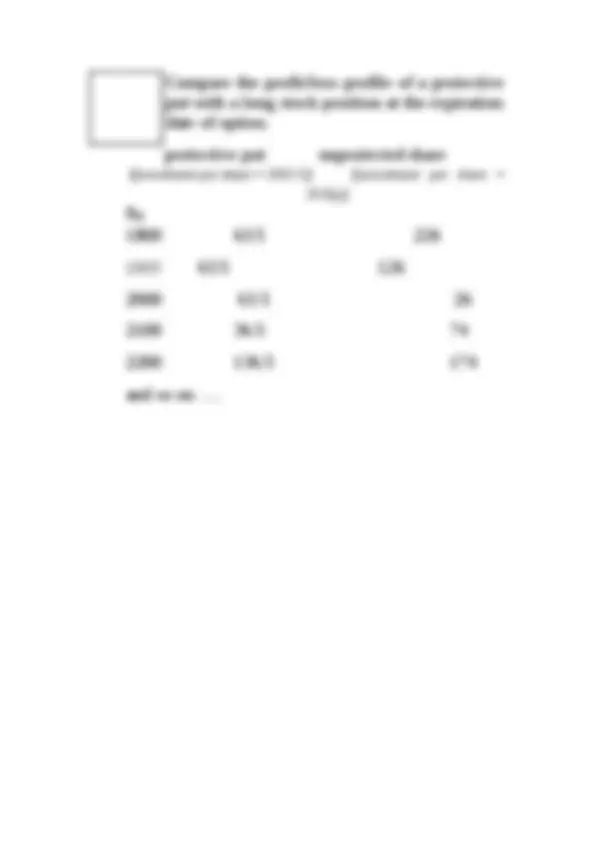
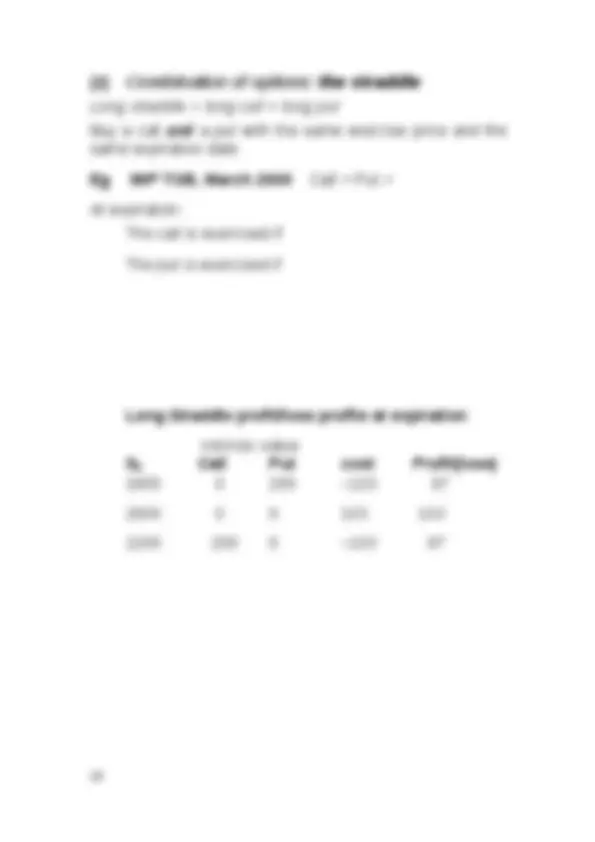

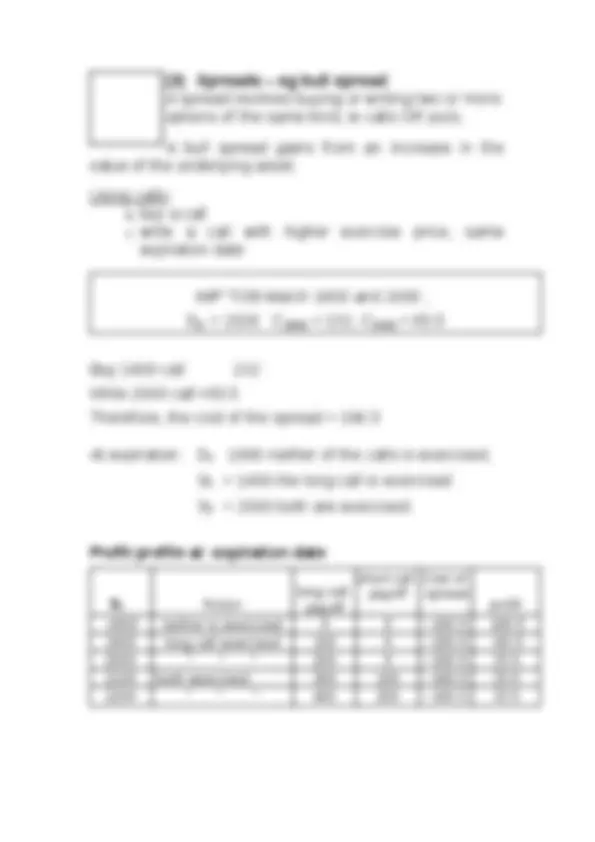
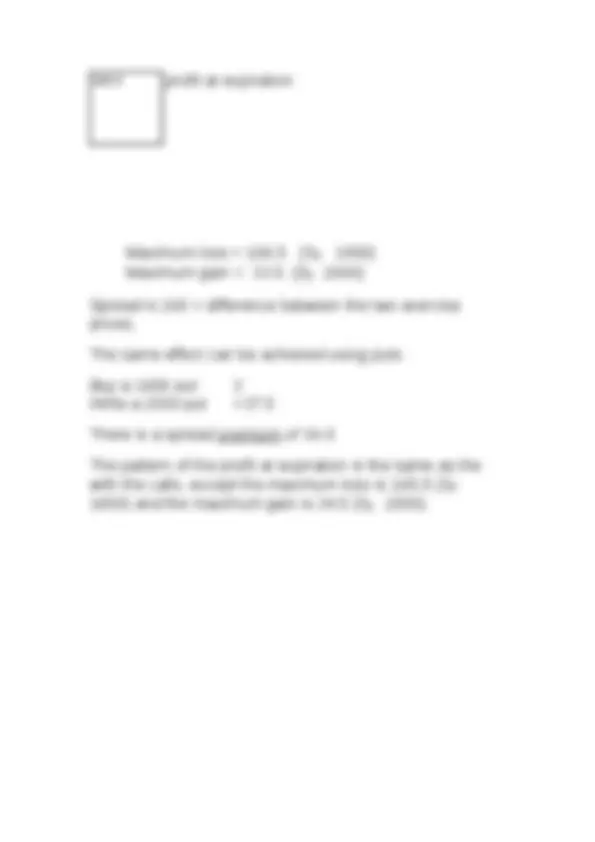
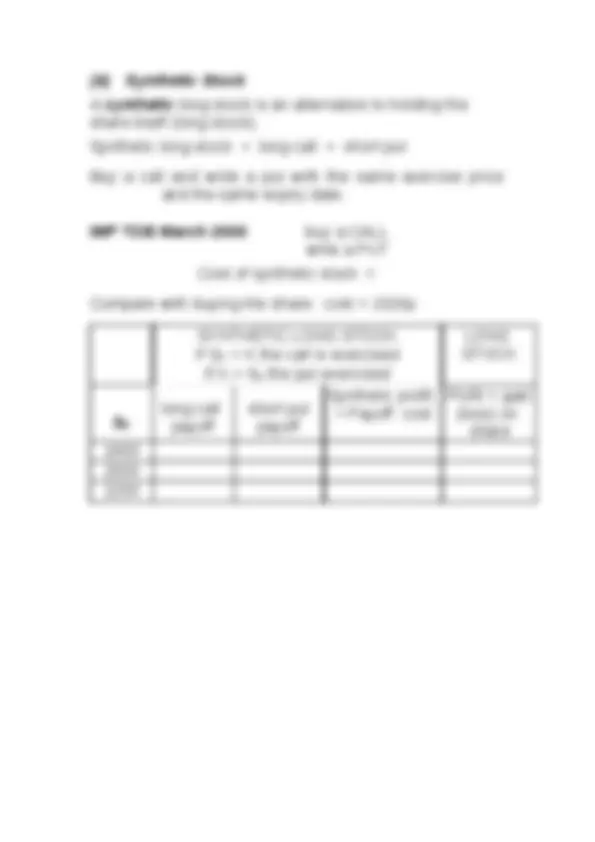

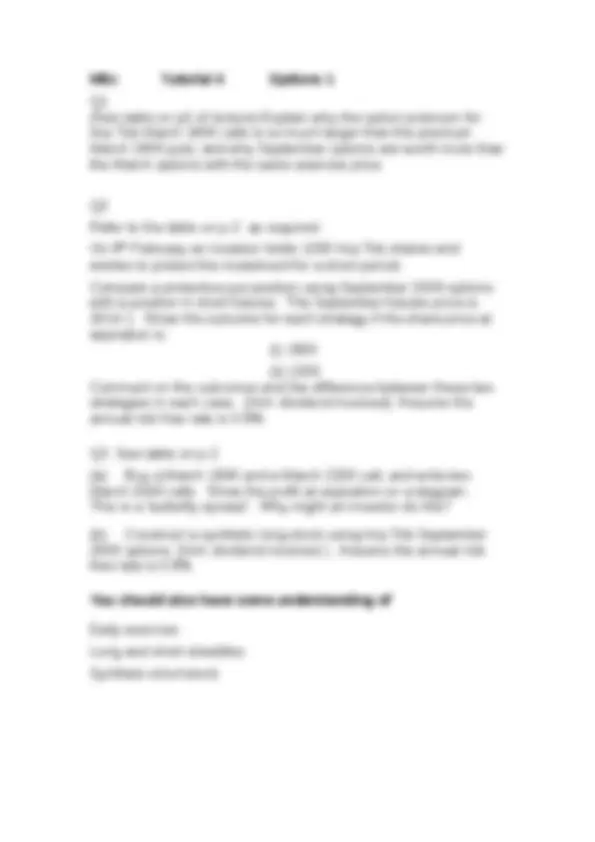


Study with the several resources on Docsity

Earn points by helping other students or get them with a premium plan


Prepare for your exams
Study with the several resources on Docsity

Earn points to download
Earn points by helping other students or get them with a premium plan
Community
Ask the community for help and clear up your study doubts
Discover the best universities in your country according to Docsity users
Free resources
Download our free guides on studying techniques, anxiety management strategies, and thesis advice from Docsity tutors
In this document topics covered which are INTRODUCTION TO OPTIONS ,Calls and Puts.EQUITY OPTIONS - example, INTRINSIC VALUE AND TIME VALUE.
Typology: Lecture notes
1 / 24

This page cannot be seen from the preview
Don't miss anything!

















MSc O&F 2010
Like futures, options are derivative assets.
Difference 1: A futures contract is an ‘obligation’
An option is a ‘right’.
Difference 2: A futures contract has a zero cost. Options have a price (the option premium )
Call option:
Put option:
An investor who buys an option is the option holder.
An investor who sells an option is the option writer.
The option holder makes the decision on whether to exercise the option.
It is a right not an obligation. Calls
If the holder exercises her right to buy, the writer is required to deliver the asset at the specified price.
Puts If the holder exercises his right to sell, the writer takes delivery of the asset at the specified price.
EQUITY OPTIONS - example Imperial Tobacco at close of trade on 5 th February 2010 (data from LIFFE)
Imp Tob 5 th^ February 2010 call premiums put premiums
Spot price
Exercise prices
19 th March 42 days
17 th Sept 224 days
19 th March 42 days
18 th Sept 224 days 2026 1800 232 271.5 3 52 2000 65.5 138.5 37.5 124. 2200 4 56 176.5 244
Underlying asset: Imperial Tobacco shares Current share price: 2026
Exercise, or ‘strike’, prices: 1800, 2000, 2200
Option Expiration dates : 20 th^ March and 18th
September
Option premiums: these are the option prices, shown under the contract dates for each exercise price
Eg a March CALL, exercise price 2000, costs 65.5p
NB One equity option contract is for 1000 shares.
23
All prices In pence
September 1800 put, premium 52p
This is the right to sell a share for 1800.
The share is trading at 2026 in the spot market.
September 2200 put, premium 244p
This is the right to sell a share for 2200.
The share is trading at 2026 in the spot market.
23
Two key elements of option value
Intrinsic value
Underlying asset value = S
Exercise price = K
Call option: Intrinsic value = S – K
Put option: Intrinsic value = K– S
“In the money” = option has intrinsic value.
“Deep in the money” = substantial intrinsic value.
“Out of the money” = zero intrinsic value
“At the money ” means K = S
Time value
Calls: time value is based on the chances of the underlying asset increasing in value before expiration.
Puts: time value is based on the chances of the underlying asset decreasing in value before expiration.
Other things equal, long dated options have more time value than short dated options. This is because there is more time for a large change in the value of the underlying asset to occur.
American and European Options
Most options can be exercised at any time up to and including the expiration date.
These are known as American options.
Options which can be exercised only at the expiration date , and not before, are known as European options.
‘Early exercise’
Early exercise means exercising the option before the expiration date (only possible with American options).
When an option is exercised the holder gets the intrinsic value. If an option is exercised early the time value is lost. In most cases options are “worth more alive than dead”. Early exercise kills the option and sacrifices the time value.
There may be circumstances in which early exercise is optimal, mostly cases of ‘deep in the money’ puts.
It is less common for call options to be exercised early but it can be worthwhile if a call is deep in the money + a large dividend is due on the underlying asset + the time to expiration is short.
Early exercise of puts
Early exercise may be optimal when the underlying asset value is low and intrinsic value is high.
In general, the incentive to exercise a put early is greater when:
Extreme case: S = 1 K = 100 T = 0.5 r = 5%
Intrinsic value of a put option is K S = 100 1 = 99
23
Imp Tob options (see p.2)
Buy a 1800 call (long call) on 5 th^ February
March 1800 call S (^) O = 2026, K = 1800, C (^) O = 232
At the expiration date exercise the option ONLY IF it has intrinsic value, ie ST > K
Value of the call option at expiration = INTRINSIC VALUE
Call value = ST K
Profit = Intrinsic value cost of call
= (ST – K) – CO
Eg ST = 1900 Intrinsic value =
Profit =
Eg ST = 2100 Intrinsic value =
Profit =
Note
Do not exercise if ST 1800 [ loss = C (^) O = 232 ]
Exercise only if ST 1800
Profit occurs if S (^) T 2032 ie when the intrinsic value is greater than the 232p cost of the call option.
23
Profit(Loss) at expiration:
ST Profit(loss) 1800 or less do not exercise 232
1900 exercise 132 2032 exercise 0 2100 exercise 68 2200 exercise 168 and so on
NOTE: the call option writer receives the premium from selling the call, and therefore achieves a profit(loss) equal and opposite to the above.
Profit/loss at expiration: ST Profit(loss) 2000 or above 37. do not exercise
1975 exercise 12.
1900 exercise 62.
1800 exercise 162.
and so on
NOTE: the put option writer receives the premium from selling the put, and therefore achieves a profit/loss equal and opposite to the above.
Some strategies using options
Protective put = long stock + long put
A protective put protects an investment by restricting the possible losses.
Illustration: you have 10,000 IMP TOB shares valued at 2026p each. (Total value £202,600)
You decide to protect the investment using March 2000 puts
Exercise price = Put premium =
Protective put compared with unprotected position
Protective put Long Stock
Share cost
Put cost
23
Protective put vs short futures
Protective puts and short futures are sometimes regarded as alternative methods for hedging an asset position.
However, they are different in terms of outcome.
The futures price for 19th^ March contracts on 5 th^ February was 2027.7.
S 0 = 2026 F 0 = 2027.
Compare a short futures position with the protective put illustrated on the previous page.
Outcomes
Eg ST = 1800
Protective put : loss = 63.5 (see previous page)
Short futures: convergence F (^) T = S (^) T = 1800
23
Eg ST = 2200
Protective put : gain = 136.5 (see p.14)
Short futures: convergence F (^) T = S (^) T = 2200
profit
(3) Spreads – eg bull spread A spread involves buying or writing two or more options of the same kind, ie calls OR puts.
A bull spread gains from an increase in the value of the underlying asset.
Using calls: b. buy a call c. write a call with higher exercise price, same expiration date
IMP TOB March 1800 and 2000 , S (^) O = 2026 C 1800 = 232, C 2000 = 65.
Buy 1800 call 232
Write 2000 call +65.
Therefore, the cost of the spread = 166.
At expiration: ST 1800 neither of the calls is exercised.
ST > 1800 the long call is exercised ST > 2000 both are exercised.
Profit profile at expiration date
ST Action
long call payoff
short call payoff
Cost of spread profit 1800 neither is exercised 0 0 −166.5 166. 1900 long call exercised 100 0 −166.5 -66. 2000 “ “ “ 200 0 −166.5 33. 2100 both exercised 300 100 −166.5 33. 2200 “ “ “ 400 200 −166.5 33.